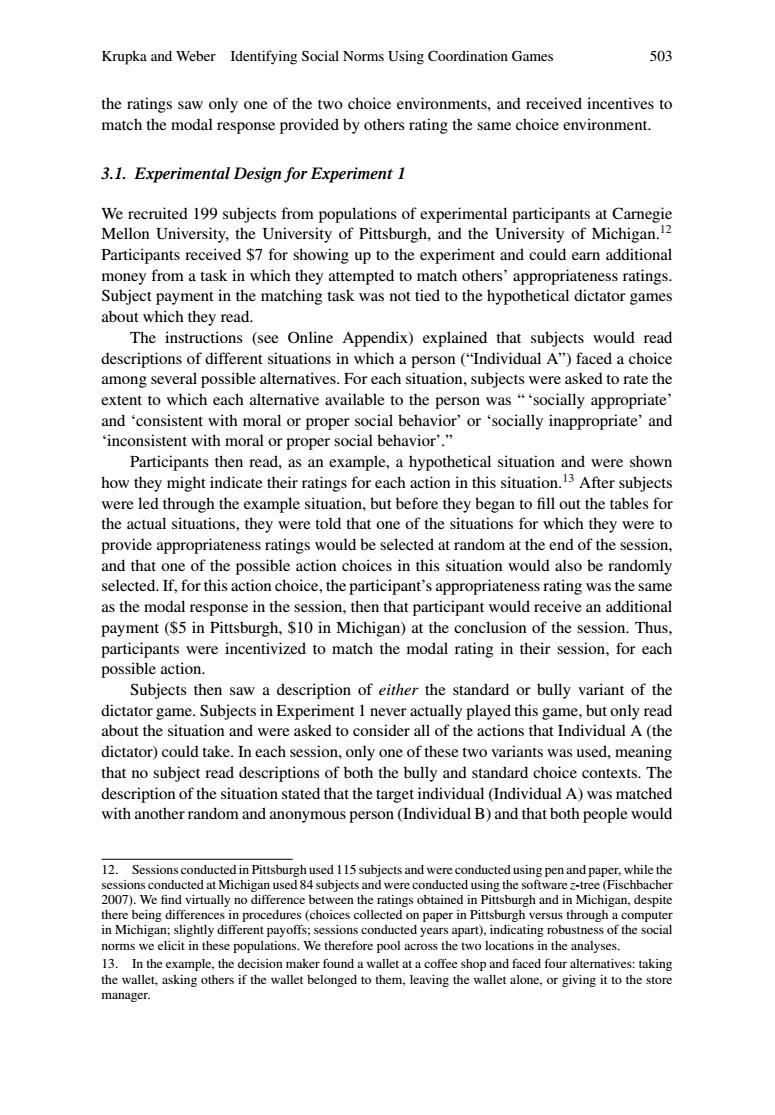正在加载图片...

Krupka and Weber Identifying Social Norms Using Coordination Games 503 the ratings saw only one of the two choice environments,and received incentives to match the modal response provided by others rating the same choice environment. 3.1.Experimental Design for Experiment 1 ms of expe partic pants at Car Participants received S7 for showing up to the experiment and could earn additional money from a task in which they attempted to match others'appropriateness ratings. Subject payment in the matching task was not tied to the hypothetical dictator games about which they read. The instru ions (see Online Appendix)explained that subjects would read descriptions of different situations in which a person("Individual A")faced a choice among several possible alternatives.For each situation,subjects were asked to rate the extent to which each alterative available to the person was "'socially appropriate' and 'consistent with moral or proper social behavioror'socially inappropriate'and inconsistent with mo ral or ocial behavior how they might indicate their ratings for each action in this situation.3 After subjects were led through the example situation,but before they began to fill out the tables for the actual situations,they were told that one of the situations for which they were to dhatoicehtobedmy e possible choices in this situation would also be e randomly as the modal response in the session,then that participant would receive an additional payment($5 in Pittsburgh,$10 in Michigan)at the conclusion of the session.Thus, participants were incentivized to match the modal rating in their session,for each Subjects then saw a description of the standard or bully variant of th dictator game.Subjects in Experiment 1 never actually played this game,but only read about the situation and were asked to consider all of the actions that Individual A(the dictator)could take.In each session,only one of these two variants was used,meaning that no subject read descriptions of both the bully and standard choice contexts.The descriptio of th on stated that the target individual (IndividualA)was matche with another random and anonymous person(Individual B)and that both people would th 20 and Mic akin the the wallet belonged to them.eavin the allet the store manager Krupka and Weber Identifying Social Norms Using Coordination Games 503 the ratings saw only one of the two choice environments, and received incentives to match the modal response provided by others rating the same choice environment. 3.1. Experimental Design for Experiment 1 We recruited 199 subjects from populations of experimental participants at Carnegie Mellon University, the University of Pittsburgh, and the University of Michigan.12 Participants received $7 for showing up to the experiment and could earn additional money from a task in which they attempted to match others’ appropriateness ratings. Subject payment in the matching task was not tied to the hypothetical dictator games about which they read. The instructions (see Online Appendix) explained that subjects would read descriptions of different situations in which a person (“Individual A”) faced a choice among several possible alternatives. For each situation, subjects were asked to rate the extent to which each alternative available to the person was “ ‘socially appropriate’ and ‘consistent with moral or proper social behavior’ or ‘socially inappropriate’ and ‘inconsistent with moral or proper social behavior’.” Participants then read, as an example, a hypothetical situation and were shown how they might indicate their ratings for each action in this situation.13 After subjects were led through the example situation, but before they began to fill out the tables for the actual situations, they were told that one of the situations for which they were to provide appropriateness ratings would be selected at random at the end of the session, and that one of the possible action choices in this situation would also be randomly selected. If, for this action choice, the participant’s appropriateness rating was the same as the modal response in the session, then that participant would receive an additional payment ($5 in Pittsburgh, $10 in Michigan) at the conclusion of the session. Thus, participants were incentivized to match the modal rating in their session, for each possible action. Subjects then saw a description of either the standard or bully variant of the dictator game. Subjects in Experiment 1 never actually played this game, but only read about the situation and were asked to consider all of the actions that Individual A (the dictator) could take. In each session, only one of these two variants was used, meaning that no subject read descriptions of both the bully and standard choice contexts. The description of the situation stated that the target individual (Individual A) was matched with another random and anonymous person (Individual B) and that both people would 12. Sessions conducted in Pittsburgh used 115 subjects and were conducted using pen and paper, while the sessions conducted at Michigan used 84 subjects and were conducted using the software z-tree (Fischbacher 2007). We find virtually no difference between the ratings obtained in Pittsburgh and in Michigan, despite there being differences in procedures (choices collected on paper in Pittsburgh versus through a computer in Michigan; slightly different payoffs; sessions conducted years apart), indicating robustness of the social norms we elicit in these populations. We therefore pool across the two locations in the analyses. 13. In the example, the decision maker found a wallet at a coffee shop and faced four alternatives: taking the wallet, asking others if the wallet belonged to them, leaving the wallet alone, or giving it to the store manager